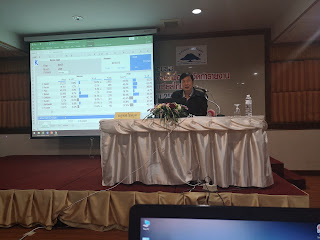The results of academic service project assessment in
Thasap sub-district (figure ), which was researched by CIPP model, were as
follow:
1) C: Context
Context was assessed
by committees, it was found that overview assessment were at the high level (X= 3.86, S.D. = 0.96). The most subject which
respondents assessed was suitability and consistency was project’s rationale,
objectives and goal at the highest level (X = 4.22,
S.D. = 0.97).
Secondary, project atmosphere, such as environment, places etc., at the high level (X = 3.89, S.D. =
0.78).
2) I: Input
Input was assessed
by committees and project responsible. Committees’ assessment, it was found that
overview assessment were at the high level (X= 3.37, S.D. = 0.89). The most subject which
respondents assessed suitability and consistency was quantity of personnel at the high level (X = 3.79, S.D. =
0.60).
Secondary, project budget, at the high level (X = 3.89, S.D. =
0.33). And
project responsible, it was found that overview
assessment were at the high level (X= 3.62, S.D. = 0.63). The most subject which
respondents assessed suitability and consistency was quantity of personnel at the high level (X = 4.11,
S.D. = 0.60).
Secondary, project budget, at the medium level
(X= 3.30, S.D. = 1.05).
3) P: Process
Process was assessed
by project responsible, it was found that overview assessment were at the high
level (X= 3.41, S.D. = 1.01). The most subject which
respondents assessed suitability and consistency was completeness of
activities procedures at the high level (X = 3.61, S.D. =
0.93).
Secondary, activities planning at the high level (X = 3.58, S.D. = 1.03).
4) P: Product
Product was
assessed by attendees; include school teachers and administrators, students,
youth groups, general people, and career, farmer, and elderly groups. 1) School
teachers and administrators assessed overview at the high level (X= 3.79, S.D. = 0.76). The most subject which
respondents assessed satisfaction was knowledge and ability of
keynote speaker at the high level (X = 3.83, S.D. =
0.82).
Secondary, building network at the high level (X = 3.83, S.D. =
0.68). 2)
Students assessed overview at the high level (X = 4.07, S.D. =
0.89).
The most subject which respondents assessed
was survey need of before doing project the highest level (X = 4.20, S.D. =
0.86).
Secondary, knowledge and ability of keynote speaker at the high level (X = 4.09, S.D. =
0.91). 3)
Youth groups assessed overview at the high
level (X = 4.35, S.D. =
0.68).
The most subject which respondents assessed
was overview satisfaction at the high level (X = 4.30, S.D. =
0.69).
Secondary, building network at the highest level (X = 4.27, S.D. = 0.68). 4) General people assessed overview at the highest level (X = 4.02, S.D. =
0.65).
The most subject which respondents assessed
was utilization knowledge from project at the highest level (X = 4.30, S.D. =
0.69).
Secondary, processes and procedures of
activities at the highest level (X = 4.33, S.D. =
0.71).
And 5) career, farmer, and elderly groups assessed
overview at the high level (X = 4.17, S.D. =
0.72).
The most subject which respondents assessed
was overview satisfaction at the highest level (X = 4.31, S.D. =
0.70).
Secondary, knowledge and ability of keynote speaker at the highest level (X = 4.26, S.D. =
0.71).







